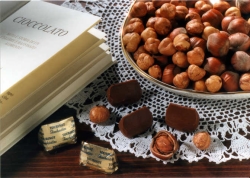Turin
Turin, Italy's Alpine Jewel
The city of Turin is distanced, geographically and culturally,
from the languid Mediterranean style that became the Italian
stereotype. At times the Torinese, meticulous, hard-working and
fond of skiing, are more like the Swiss than Italians. That is,
until it comes to food, when they are as obsessed with fine cuisine
as any Roman or Neapolitan.
Order characterises Turin, starting with the street plan. All
roads lead to the Via Roma, a broad and graceful avenue linking the
grand railway station with the remains of the Roman theatre.
Turin's version of the passeggiata evening stroll involves
window-shopping in some of those exclusive fashion outlets that
exemplify Italian style.
Turin isn't quite as fashion-obsessed as Milan. The intellectual
side of the city thrives in the coffee-shops and bookstores of the
Via Po, where the city gets solemn and thoughtful. The philosopher
Friedrich
Nietzsche couldn't get enough of its piazzas, and did some his
best thinking over a Turin coffee.
He was intrigued by Turin's obsession with the occult and
mystery. In medieval times the city was associated with alchemy and
magic. Nostradamus, famous for his cryptically-worded predictions,
lived on Via Michele Lessona. A modern Torinese mystic, Gustavo Rol, provided readings for
Mussolini, JFK and Ronald Reagan.
Since 1587, Turin's spiritual claim to fame has been the
controversial Shroud. When carbon dating suggested the fabric was
only 700 years old, pollen analysts countered with evidence that
the relic was much older. The Catholic Church tired of the
arguments and limited access to the Shroud. It was last displayed
in May 2010. It is kept hidden in the Cappella della Sacra Sindone
in the impressive Cathedral.
For a serious city, Turin has one of Italy's most garish tourist
attractions. The Mole Antonelliana looks like it has been assembled
from leftovers from a Greek temple and an Egyptian pyramid, with a
mini Eiffel Tower attached. The glass lift up to the tower parapet
offers great views over the city and north to the Alps.
The bizarre building houses the Museum of Cinema. This being
Italy, even the earliest magic lantern shows showcased the sort of
scantily-clad girls who still feature prominently on Silvio
Berlusconi's TV channels.
The locals love cinema, and the city supports a thriving
art-house scene. It cannot compete though with one of Turin's
obsessions; football. Torino was once the city's most prominent
team, until the tragic loss of their greatest side in 1949, when
their plane crashed into the Superga hill to the east of the city.
Juventus, known as the "Old Lady", is now the dominant force in
Turin, filling the brand-new stadium for most home games.
The other obsession is food. Piedmont cuisine is rich with
butter and dairy produce. Typical dishes in Torinese restaurants
will include the inevitable bagna cauda, a piquant sauce of butter,
anchovy, olive oil and garlic that combines flavours of north and
south.

Guido Gobino Cioccolato
Turin also has a sweet tooth. Some of Italy's finest
chocolatiers such as Guido
Gobino originate from the city. In March, the annual
chocolate festival CioccolaTÒ finds
local restaurateurs competing to come up with the most
inspired chocolate recipes. It's an occasion when traditional Turin
restraint is, for once, forgotten.